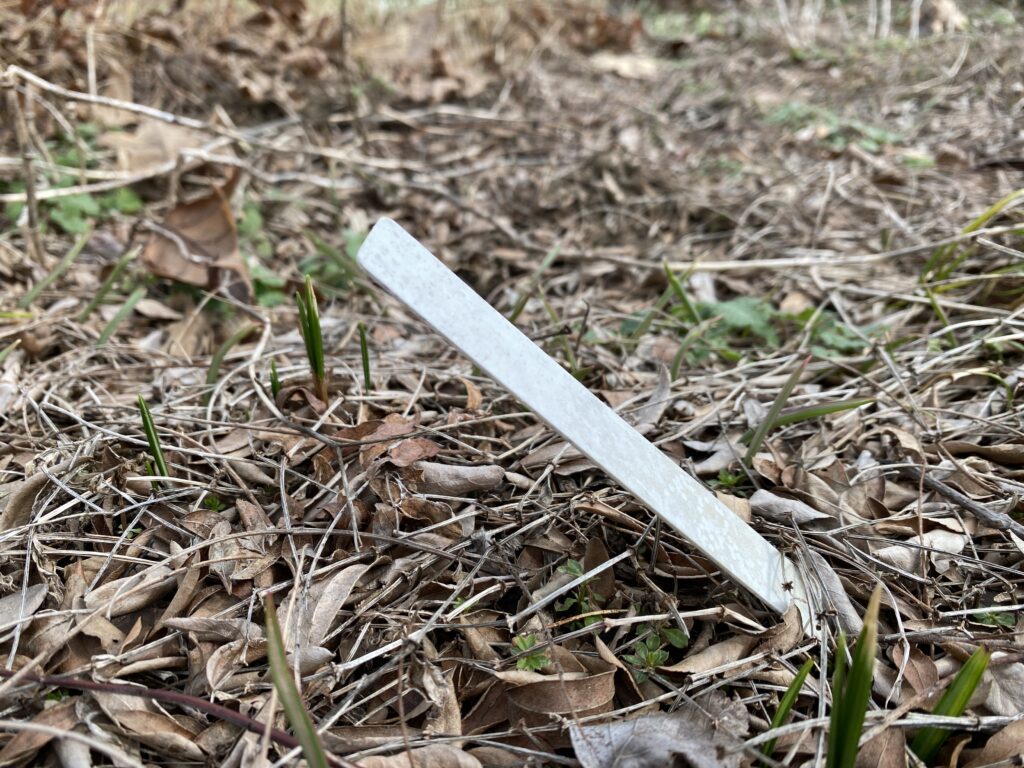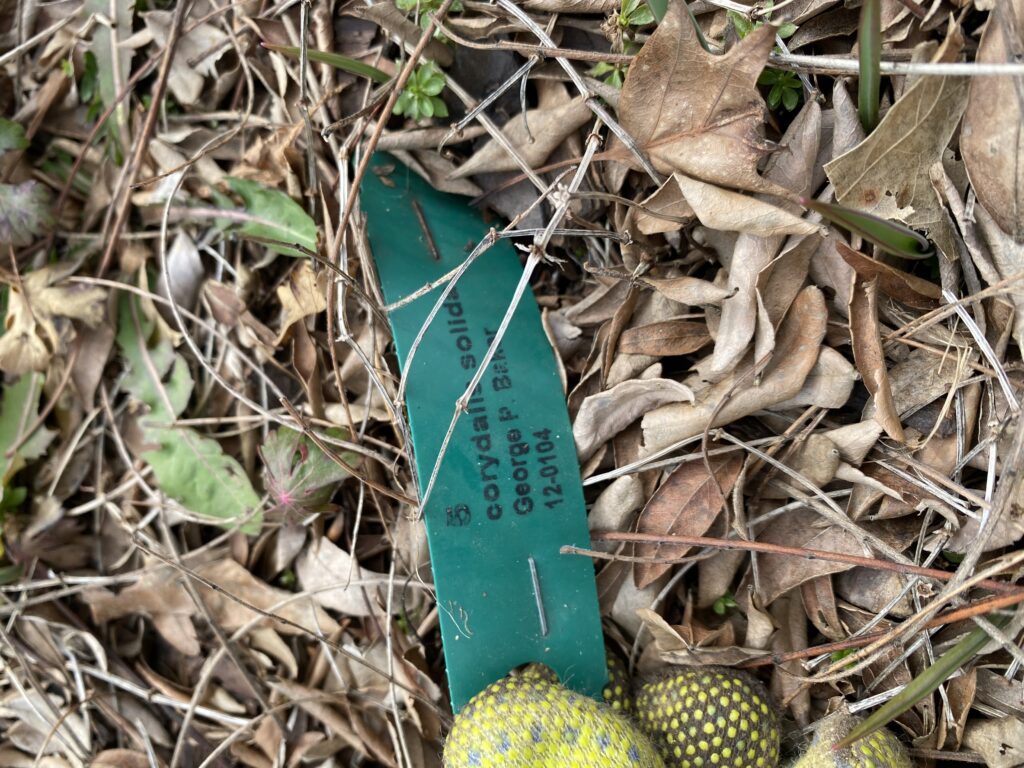
What is a proper plant label?
Clearly, this isn’t a proper plant label because the writing has worn off. I have no idea what it is marking, but it is out in a flower bed where I was weeding the other day.
Yes, weeding. In February. Because the chickweed and creeping charlie (or is it henbit?) are already beginning to claim their ground. And I’m not going to allow them to do so.
But back to labels.
The real question is, of course, to label or not to label plants in the garden.
We would all agree that we should, and do, label all those little containers of seedlings. And we should label rows of different kinds of lettuces, such as the 12 kinds I’m sowing seeds for this spring. (Dee and I talked about how it came to be that I have 12 varieties of lettuce to sow on this week’s podcast episode.)
But what is a proper plant label?
Kate L. Brewster (I just wrote a new Substack article about her), author of The Little Garden for Little Money (1924), has some ideas about label plantings. And I quote.
…so count yourself a bad gardener until you have learned to label conscientiously and thoroughly. It is one of the mechanical details of gardening that the newcomer undervalues but that the old-timer never neglects.
Ouch.
I’ve not been a conscientious labeler in the garden for quite some time, but I do consider myself an old-timer.
Oh, sure sometimes when planting something, if the seller included a nice label, I’ll stick it in the ground nearby.

And yes, I admit that labels are helpful for those plants that come up in early spring, flower, and then die back down before summer gets going. It does keep me from digging too ambitiously in that general area.
But back to Kate’s advice. For seedlings, she recommends:
…Their first use is to mark the rows of seeds and the pots or boxes in which seeds are planted. For this purpose, the little white wood four-inch labels are sufficient but on them should be written the variety, color, and date of planting. The most satisfactory method is to use two of these labels, one to cover the writing on the other, and keep it clean and bright through all the various operations of watering, weeding, and weather.
Hmmm, am I to understand that her advice is to put one label over the other label to keep the label with the writing clean? Hmmm… I probably won’t do that.
Some of her other plant labeling advice was for plants out in the garden.
Eight-inch wooden labels are better for marking plants bulbs and even seeds planted in the open beds. Smaller ones are too inconspicuous and will surely disappear during cultivation or be forked in or out with the winter covering. Always use these double. They are readable for years if set close together with the writing inside so that rain and mud cannot get between them.
There’s that double-label advice again. I suppose if I had done that for the mystery label I pictured at the top of this post, I might know what it was for. The other tip, from me, is to use a pencil which tends not to fade as much as “permanent markers” do. Or use something like the Epson printer I’ve written about to print labels to put on those white plastic labels.

Her final advice on plant labeling is:
For marking the permanent plants whose variety it is interesting to know, such as peonies, irises, roses, and such shrubs as lilacs and Philadelphus which now have so many beautiful new hybrids, more permanent zinc labels should be used. These can be bought but it is more satisfactory to have them made at the tinsmith’s, having them cut the size and shape you prefer. A good size is about 3 x 1-1/2 inches with a hole at one end for copper wire by means of which they can be fastened to galvanized wire stakes and stuck deeply and firmly into the ground so that no fork or spade will disturb them close to the roots of the plant they mark. A fluid is manufactured for marking zinc labels but indelible ink applied with a sharpened stick instead of a pen is quite satisfactory and will last for years. The original cost of such labels is an item but in the end they are cheap and you and your garden visitors will find in them pleasure and profit.
I freely admit that I have never marked any permanent plants in this manner, though I’ve seen zinc labels in other gardens. The closest I’ve come to a marker for a permanent plant is some lovely, and probably too expensive for most gardeners, plastic engraved labels that Proven Winners thoughtfully included with some hydrangeas they sent me last year to trial in my garden. I put them behind the shrubs because unless I’m in a public garden, I really don’t like to see plant labels in a garden.

I’ve quoted almost all of what Kate wrote about labeling, so I’ll wrap this up with the last of her advice.
For bulbs and perennials which quite disappear after they have bloomed some sort of marker is essential, not so much tell what they are as where they are. Otherwise the spring uncovering and cultivating will claim many a victim and annuals will be required to fill the spots where permanent perennials once grew. This is expensive in three ways: the original plants are wasted after purchase and a year or two of care; annuals must be grown to provide for contingencies; and time must be spent in setting them out.
And there you have it… all the advice you’ll ever need, and didn’t know you needed, from 1924, 100 years ago, about why and how to label plants!


I have tried many labels in my lifetime and find the galvanized ones are the best. I put labels on all my new plants. Especially the pots of bulbs. I have bought several different types but the cheapest are used vinal not metal window blinds. Our garden club uses these if we have enough, #2 pencil will last many years. I decided not to use the vinal in my garden areas just my pots just because they are mostly white and a young man visiting my garden laughed and said the labels looked like tombstones for my plants! oh well. I do use my label maker for the metal ones. They haven’t faded ever. I have my galvanize trash cans for soil and amendments labeled and they have been on them for over 10 years.
I’ve started to make my own out of emboss-able tin (ok I don’t really know what it’s called). They are tin rectangles and I have a metal stamping kit (hit the stick and it embossed the letter). It’s a bit time consuming so I’ve only labeled the roses so far.
How interesting to see how gardeners labeled plants before plastic and Sharpies were readily available. For temporary labels, such as seedlings and plants I’m giving away, I use strips cut from 32 oz yogurt tubs. For most plants I use standard plastic labels and write with an Industrial sharpie (super permanent, it says. Still testing this.) But I write the most critical info on both ends. It is legible for much longer on the end that goes in the dirt. And if someone steps on it and snaps it in two, the part in the ground is still available for i.d. For my colchicum collection I used Pawpaw zinc labels with clear labels printed with a laser printer. When you press them on the zinc, it looks like it’s directly printed on the zinc. To my dismay, many of these labels have gotten bent or twisted. Thought they would be more durable. However, they still do the job of providing information. They just don’t look very professional anymore.
My daughter in law gave me a graphite pencil, no wood, just a solid piece of graphite. It wasn’t specifically for labeling, but it doesn’t fade on my wintersowing milk jugs. I go with the crowd in using pieces of window blinds. I got some metal off a curb for free. I haven’t been cut yet, but the ends do get sharp!